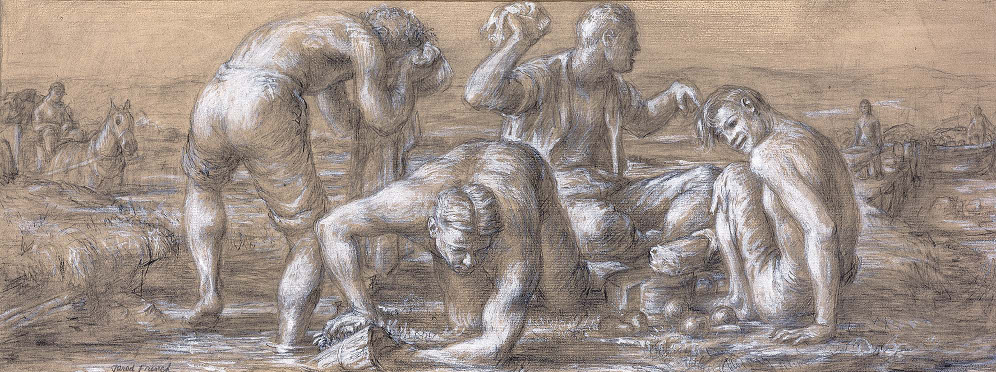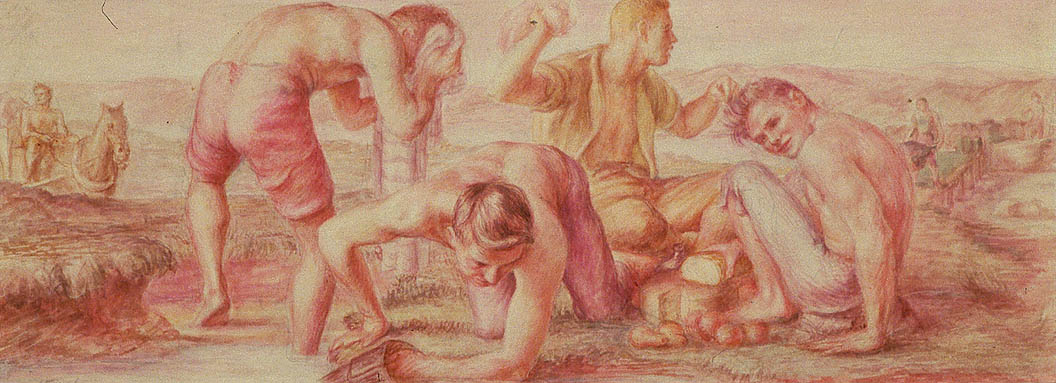Information
Plymouth, Pennsylvania was the original center of anthracite coal mining dating back to 1808. Jared French's mural scarcely hints at the intense labor involved in this activity, but instead shows a leisurely luncheon along the Susquehanna River. The mural has the amusing distinction of showing the only nude figure in any of the Post Office murals, as the following posting from the Plymouth Post Office describes:
MURAL PAINTING BY JARED FRENCH
Commissioned in December of 1935, this mural is one of approximately one thousand murals that were installed in post offices by the Treasury Department's Section of Fine Arts between 1934 and 1943. Unlike Great Depression programs such as WPA, these murals were not intended as relief and were often awarded to artists based upon their entrance in a sponsored competition. Jared French received the commission for the Plymouth post office based upon the drawings he submitted in a national competition.
While preparing to paint this mural, French read several books concerning coal mining during the early 1800s. He chose to depict a river bank operation where coal was brought to have the excess slate chipped away. From there, the coal was loaded into barges and transported down the Susquehanna river. French's composition shows the miners at meal time during a period he describes as between 1808 and 1850.
While painting this mural, Jared French was invited to paint another for the for Richmond Parcel Post building. The subject he chose for this mural was an event from the Civil War. In June 1862, General Stuart's Confederate Cavalry rode a complete circle around McClellan's Union Army. At one point of this famous three day ride, the troops had to cross a swollen river and, as was custom, stripped naked so they would not have to ride the remainder of the day in wet clothes. French's mural was true to every detail, however, the women of Richmond were not so interested in historical accuracy. In a seething letter, the Section of Fine Arts informed Jared French that he must paint trousers on the soldiers immediately. French followed the Section's wishes but must have found it amusing that the Section of Fine Arts never discovered the nude he had cleverly hidden in the Plymouth post office mural.
For this mural, French received a commission of $590. He received $200 when the preliminary sketches were approved; $190 when the mural was half-way completed; and the balance of $200 when the mural was completed, installed and approved by the Section of Fine Arts. From this money, he had to pay for his own travel expenses, art supplies, professional installation of the mural and his wages. After three years the mural was finally installed in February 1938.
The Section of Fine Arts was only one the Great Depression's four Federal programs to support artists. The Public Works of Art Project (PWAP), Treasury Relief Art Project (TRAP) and Works Progress Administration Federal Art Project (WPA/FAP), tried to employ artists more upon their need than talent. These programs covered easel paintings, prints, theater, music and writing. The Section of Fine Arts concentrated mainly on murals and sculptures to be placed across America in small town post offices.
Other Section of Fine Art murals can be seen locally in the Wilkes-Barre Kingston Branch, West Scranton Branch, Freeland and Tunkhannock post offices.
The Smithsonian Institute has two of French's studies for his Plymouth mural. The following images are linked to the Smithsonian's Web site:


